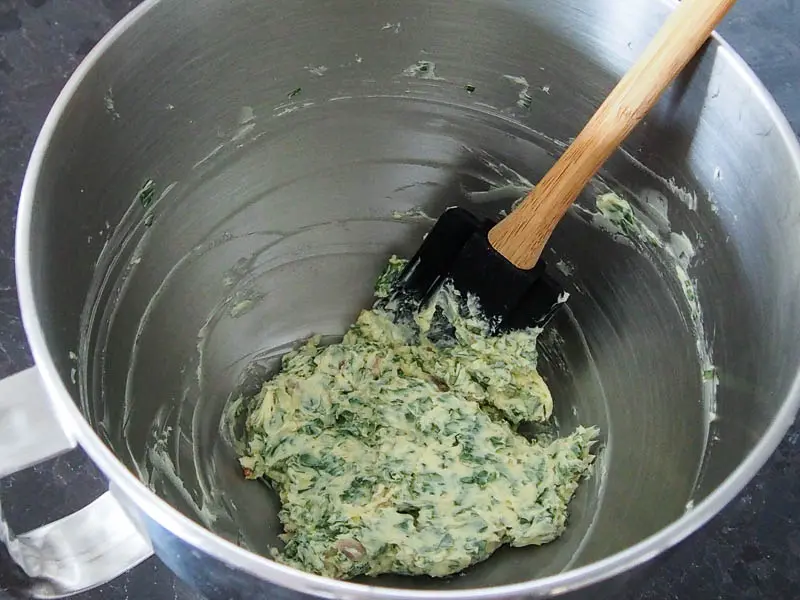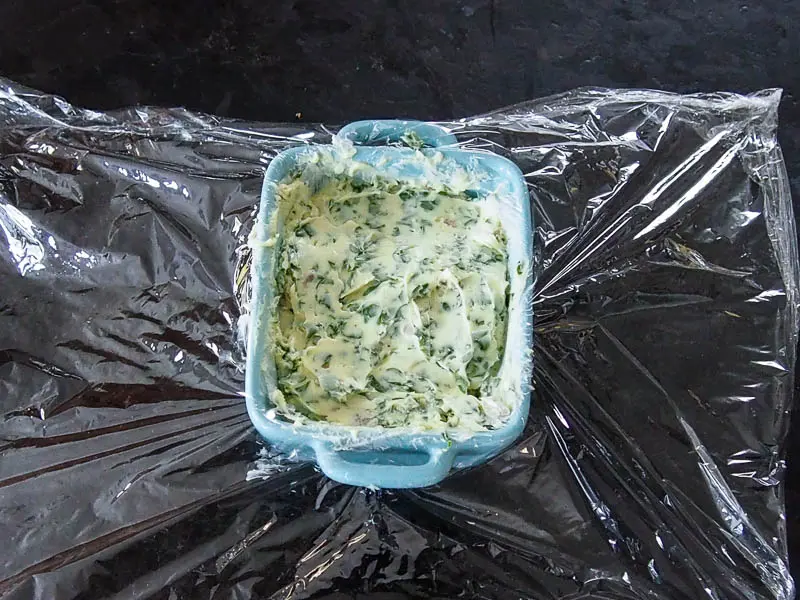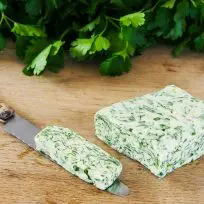Compound butter made by mixing butter with shallot and parsley, called snail butter, as its original destination in Burgundy, creating a flavorful and aromatic blend that can be used in a variety of ways.
This staple of French cuisine is a versatile spread that adds flavor and richness to any dish.
No real snails here. This is a French compound butter (called beurre composé in French), a homemade butter flavored with parsley, garlic, and shallot. Called beurre d’escargot in French (the English translation being snail butter), it is named after its original use in the preparation of Burgundy snails.
How to use this compound butter
There are many other possible uses of this compound butter other than for snails, to add flavor and richness:
- in cooking for sautéed ingredients. The best I can imagine are potatoes or mushrooms. The butter will infuse your dish with rich flavor that will make it stand out.
- as a seasonning for fish or grilled meat, put on when dressed, or placed in a jar on the table.
- to flavor a sauce, combined with cream for example to get a flavored sauce. This can be served with shellfish instead of mayonnaise.
- as a seasoning for a vegetable or pasta. Imagine this butter melting on warm green beans.
- to flavor bread
Before starting the recipe, a few tips:
The butter
The key to making a good French compound butter is to choose high-quality butter.
It’s better to use unsalted butter and to season as you wish. You may use salted butter with salt crystals, which will give your preparation a little crunch (then no need to season with salt).
Butter must be at room temperature and soften with a wooden spatula so that it will be easier to incorporate the other ingredients and get a homogeneous blend.
The butter is not heated. This preparation is made exclusively of raw ingredients, which are chopped or puréed.

The other ingredients
You can chop or mince shallot, parsley leaves, and garlic more or less finely, grate or puree shallot and garlic with a microplane grater, or use a mortar.
You can also place all ingredients in a food processor and roughly mix.
Flat-leaf parsley is much more fragrant than curly parsley, at least for the varieties we find in France.
Increase the amount of garlic if you’re using snail butter to make Burgundy snails.
You can blanch the garlic for less bitterness. Plunge it into a pan of simmering water and drain as soon as the water starts to boil again. This is of course optional. Another way to prevent garlic from becoming too aggressive is to serve this compound butter immediately after preparation.
The snail butter needs to be well seasoned with salt and pepper.
Combine those ingredients with the soft butter. It’s better to do it with a rubber or wooden spatula than with a food processor, which I don’t really recommend for this step. Combine until you get a more or less homogeneous blend.

The shape
I prepare the snail butter here by forming it in a small terrine for easy use.
You can do as the chefs do: a nice, homogenous sausage made with a sheet of plastic wrap that folds at the ends and rolls to get the perfect cylinder shape. Then refrigerate as it is.
Before serving, remove the plastic wrap, make sure the shape is nicely formed, and if necessary, use the bled of a knife or a spoon to arrange the shape. Cut slices for a nice presentation.


Refrigeration
Store snail butter wrapped in plastic wrap or a closed container to prevent it from absorbing odors from other foods in your fridge.
Avoid aluminum foil, which will oxidize the butter and give it a slightly metallic taste.
Consume it reasonably quickly, as butter may go rancid prematurely due to the added raw ingredients. Snail butter is said to be kept for 1 month in the refrigerator. I prefer to keep it fresh for less than two weeks.
You can freeze the whole batch or make ahead individual portions wrapped in plastic wrap.
Servings: In France, we count on 15 to 20 grams per person.
How to make this compound butter
Butter must be slightly soft or ideally left at room temperature to incorporate minced parsley, shallot, garlic. Season with salt and pepper.
Once all ingredients are well combined, the soft compound butter must be shaped and placed in the refrigerator.
I’m giving you a rough guide here. You can adjust the proportions of each ingredient to suit your tastes or the dish you plan to serve it with.
You may need it to be more or less seasoned. Similarly, the size at which you chop or mince shallot, parsley, and garlic will affect the texture and taste.
Other French Compound butter
- Beurre maître d’hôtel with parsley and lemon
- Garlic butter with minced garlic and parsley
- Make your own personal blend with various herbs (like thyme, rosemary, tarragon, chives…), spices, lemon zest, and even cheese… Possibilities are endless to create unique and delicious flavors.

Snail Butter: A French shallot and parsley compound butter
Ingredients
- 125 gr butter unsalted, at room temperature
- 15 gr shallot chopped
- 2 gr garlic finely minced or grated
- 15 gr parsley flat-leaves, chopped
- salt
- pepper freshly grounded
Instructions
- Take butter out of the fridge and leave it on the count, you will need room-temperature butter.
- When butter is soft, prepare and weigh all the ingredients
- Chop them finely: finely chop the parsley, mince the shallot, finely mince or grate with a microplane grater the garlic.
- You may use a food processor. In the food processor or using a spatula, combine these ingredients. Make sure all ingredients are well mixed.
- Soften the room-temperature butter with a wooden spatula. Season with salt and pepper. Add the minced ingredients and combine to incorporate them in the butter.
- Place in a ramekin of the shape of your choice, covered with plastic wrap.
- Pack well and close the film to wrap the compound butter securely.
- If you prefer not to use a ramekin, make the shape of a sausage on plastic crap, roll it to form a nice cylinder shape, and fold the edges.
- Place in the fridge and serve when the butter has hardened again.
